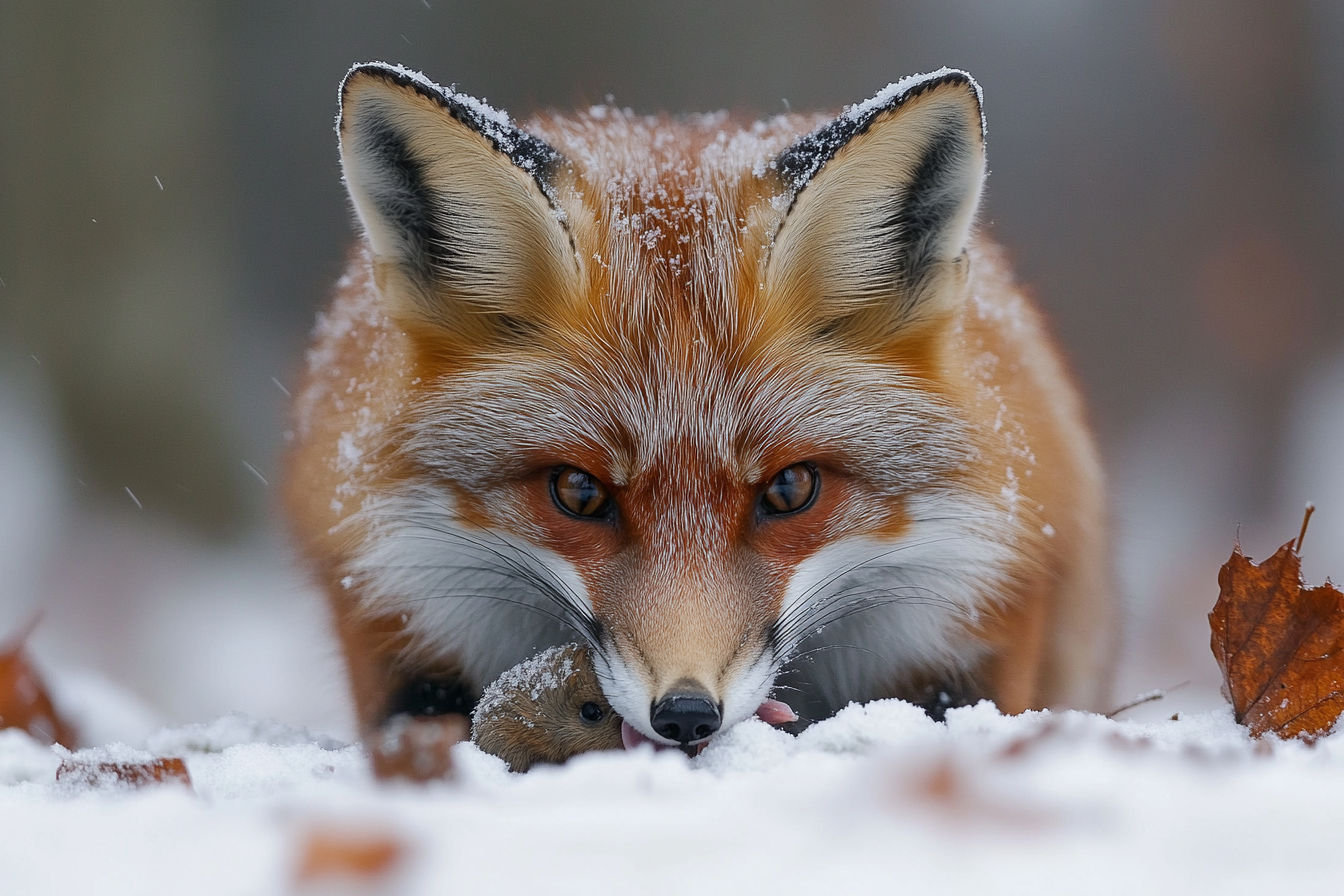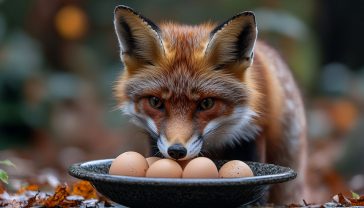What Do Foxes Eat? A Deep Dive into Their Varied Diet.
Foxes have a surprisingly varied diet, adapting to whatever their environment offers. But what exactly do they eat? Uncover the secrets of a fox’s diet in our detailed exploration.

This post may contain affiliate links. If you make a purchase through these links, we may earn a commission at no additional cost to you.
Have you ever wondered how foxes manage to thrive in environments as diverse as bustling cities, dense forests, and the icy Arctic tundra? The answer lies in their incredibly adaptable and varied diet. As omnivorous mammals, foxes consume both plant and animal matter, adjusting their eating habits based on what’s available in their surroundings.
But what exactly makes up a fox’s menu? From cunning hunts for small mammals to foraging for berries and scavenging in urban streets, the diet of a fox is as fascinating as the animal itself. Let’s explore the wide-ranging foods that sustain these clever creatures around the world.
1. Small Mammals: The Core of a Fox’s Diet
At the heart of a fox’s diet lies its primary prey—small mammals. Foxes rely heavily on rodents such as mice, voles, rabbits, and young hares, which are abundant across many habitats, including forests, grasslands, and suburban gardens.
Masterful Hunters with Precision Techniques
Foxes are highly skilled hunters, using their exceptional senses of smell, hearing, and sight to locate prey.
- Keen Smell: Detects rodents hidden beneath soil or dense vegetation.
- Acute Hearing: Picks up the faintest rustle of a mouse or vole.
- The “Mouse Pounce”: A signature hunting move where the fox leaps into the air and lands with precision on its prey, often through tall grass or snow.
This hunting prowess is more than just survival—it plays a crucial ecological role by regulating rodent populations, maintaining the delicate balance of ecosystems.
Did you know? During the breeding season, female foxes (vixens) require extra nourishment to support their young, making these protein-rich meals even more vital.
2. Birds and Eggs: Opportunistic Predation
Foxes are opportunistic feeders, and birds—especially ground-nesting species—often feature in their diet. These birds are particularly vulnerable due to nests located at ground level.
How Foxes Hunt Birds and Raid Nests
- Under Cover of Darkness: Foxes typically hunt at night, using stealth and speed.
- Raiding Nests: Eggs and hatchlings provide rich nutrition, particularly during breeding seasons when they are most abundant.
- Prey Preferences: Depending on the region, foxes may target seabirds in coastal areas or game birds like pheasants, partridges, and quails in agricultural zones.
Foxes may also target domesticated birds like chickens, bringing them into conflict with farmers. Their ability to breach even well-secured coops showcases their intelligence and persistence.
Rhetorical question: If you were a fox, would you pass up an easy meal like an unguarded nest?
3. Insects and Invertebrates: A Nutrient-Rich Supplement
During the warmer months, foxes turn their attention to insects and invertebrates, which are abundant and easy to catch.
Protein-Packed Prey for Energy
- Favourite Insects: Grasshoppers, beetles, crickets, and caterpillars.
- Reliable Invertebrates: Earthworms (especially after rain), snails, and slugs.
These creatures are rich in protein, crucial for maintaining energy during periods of high activity like raising cubs or preparing for winter.
Foxes’ Ingenious Foraging Techniques
- Pouncing on Grasshoppers: Mimicking their “mouse pounce” technique.
- Turning Over Stones: Searching for hidden beetles and worms.
- Digging for Earthworms: Particularly during wet conditions.
Surprising insight: Insects also provide roughage that aids digestion, with beetle exoskeletons offering essential dietary fibre.
4. Fruits and Berries: Nature’s Energy Boost
Foxes aren’t solely carnivorous. In fact, fruits and berries become crucial components of their diet, especially during autumn when they prepare for winter.
Favourite Fruits of Foxes
- Blackberries: Sweet, abundant, and easily accessible in hedgerows.
- Apples and Cherries: Rich in natural sugars for energy.
- Plums and Grapes: High in moisture, aiding hydration.
- Blueberries: Packed with antioxidants to support immune health.
Why Fruits Matter
Fruits provide vitamins, minerals, and natural sugars that help foxes:
- Build fat reserves for winter.
- Maintain hydration, especially in arid regions.
- Support immune function, enhancing resilience to disease.
Foxes are known to forage in urban gardens, orchards, and even beneath fruit trees in suburban neighbourhoods. Their adaptability allows them to exploit seasonal abundance, ensuring a balanced diet.
Did you know? In Mediterranean regions, foxes might consume figs, olives, and dates, while in North America, they favour cranberries and wild grapes. Such regional variations highlight their dietary flexibility.
5. Carrion: The Role of Scavenging in Survival
Foxes aren’t just hunters and foragers—they’re also adept scavengers, consuming carrion (dead animals). This behaviour becomes particularly important in winter, when hunting is difficult.
Why Carrion Matters
- Winter Survival: Scarcity of live prey makes carrion a crucial energy source.
- Ecosystem Health: By feeding on carrion, foxes aid the decomposition process, recycling nutrients into the soil and reducing the risk of disease spread.
Clever Scavenging Behaviours
- Keen Smell: Detects carcasses from considerable distances.
- Caching: Foxes often bury excess food, saving it for leaner times—a testament to their foresight.
Interesting fact: Foxes will scavenge on roadkill, livestock remains, or game left after hunting seasons, further showcasing their resourcefulness.
6. Human Food Sources: Thriving in Urban Environments
In urban areas, foxes have adapted remarkably, incorporating human-derived food into their diets.
Where Urban Foxes Find Food
- Rubbish Bins: Discarded food such as sandwiches, takeaway meals, and fruit peels.
- Pet Food: Left outdoors for cats or dogs, becoming easy pickings.
- Bird Feeders: Seeds, suet, and the occasional bird become part of their meals.
- Compost Heaps: Vegetable scraps, fruit peelings, and root vegetables like carrots and potatoes.
Impact of Human Food on Foxes
While these sources help foxes survive in cities, there are downsides:
- Nutritional Imbalances: Processed human foods may lack essential nutrients.
- Habituation: Increased comfort around humans can lead to conflicts, especially if foxes become bolder.
Rhetorical thought: With an entire city’s waste at their disposal, is it any wonder urban foxes are thriving?
7. Dietary Adaptations by Species and Region: Survival Across the Globe
Foxes around the world exhibit unique dietary adaptations tailored to their habitats:
Red Foxes (Vulpes vulpes)
- Habitat: Europe, Asia, North America, and parts of North Africa.
- Diet: Small mammals, birds, insects, fruits, carrion, and human food waste.
- Remarkable Adaptability: Thrive in rural farmlands, forests, suburban gardens, and city parks.
Arctic Foxes (Vulpes lagopus)
- Habitat: Arctic tundra.
- Diet: Lemmings, voles, seabirds, fish, and carrion (including seal remains).
- Survival Strategy: Caching prey in permafrost for harsh winters.
Fennec Foxes (Vulpes zerda)
- Habitat: Sahara Desert.
- Diet: Insects (beetles, grasshoppers), small mammals, lizards, and moisture-rich plants.
- Water Efficiency: Consumes desert melons and cacti to stay hydrated.
Grey Foxes (Urocyon cinereoargenteus)
- Habitat: North and Central America.
- Unique Trait: Arboreal abilities, allowing them to hunt birds and access fruits in trees.
- Diet: Small mammals, birds, fruits, and berries like persimmons and blackberries.
Conclusion: The Ultimate Survivors of the Wild
From the icy Arctic tundras to scorching deserts and bustling urban streets, foxes stand out as masters of adaptability. Their omnivorous, opportunistic diet—ranging from small mammals, birds, insects, and fruits to carrion and human food—is a key factor behind their global success.
Foxes are more than just clever hunters. They’re ecosystem engineers, controlling prey populations, aiding decomposition, and showcasing unparalleled survival strategies. Whether employing the iconic “mouse pounce”, raiding nests for eggs, or foraging for berries to build fat reserves, foxes demonstrate intelligence, resourcefulness, and resilience.
So, the next time you spot a fox darting through a forest path or a city street, remember: behind those sharp eyes lies a creature whose diet tells the story of survival, adaptability, and the wonders of the natural world.






